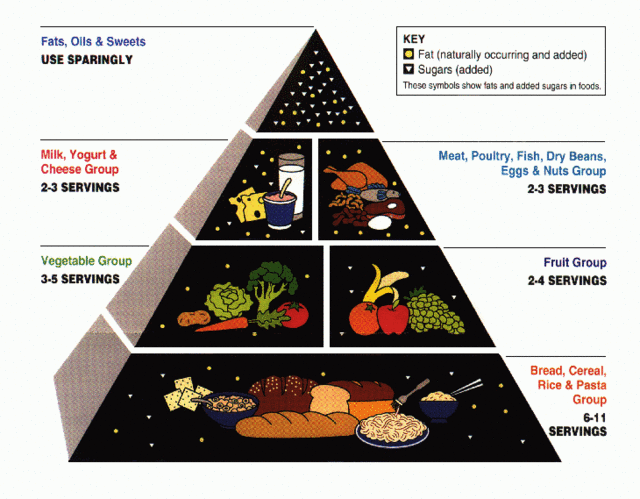The tissues of living beings are made up of carbon (C), hydrogen (H) and oxygen (O), the main compounds being water, carbohydrates (carbohydrates), proteins (proteins) and lipids (fats). In other words, all living beings are composed mainly of what they eat, which is why a balanced diet is vital to guarantee the optimal performance of the organism.

But how can we get the most out of food? Without a doubt, the first step is to know the food: what they contain, what they are for and how they work in our body. For this reason, we share a very educational article on how foods are classified, considering several very important aspects, such as their function, origin, composition and nutrients. You cannot lose this!
Classification of foods according to their function
This form of organization is based on the usefulness that the different types of food provide to the body and groups them according to this criterion as follows:
Energetic food
These provide the body with energy b to carry out physical activities (running, walking, playing sports, etc.). Some foods included in this group are:
- Bakery and pastry products (bread, cookies, muffins, cakes, puddings, etc.).
- Cereals (rice, corn, wheat, etc.).
- Sweets (ice cream, candies, chocolate, soluble cocoa).
- Honey and sugar.
- Nuts (walnuts, hazelnuts, chestnuts, almonds, mere, etc.).
- Foods in syrup (jellies, jams, etc.).
Building or plastic foods
Foods that facilitate cell repair are thus classified: wound healing and tissue formation (muscles, skin and others). This group includes products such as:
- Milk and all its derivatives.
- White and red meats.
Protective or regulating foods
This is the name given to foods that contain vitamins and minerals (also fiber). These are responsible for facilitating the control of our physiological functions and, consequently, help all the body’s processes to flow normally. Some protective foods are:
- Fruits
Classification of food according to its origin
Within the great classification of foods we can also find the organization based on their origin, that is, the source from which they come. According to this criterion we can divide them into three groups:
Vegetarian food
This type of food comes directly from the earth; although currently in agriculture in many parts of the world techniques are used that involve seeds genetically. Vegetable foods provide significant amounts of minerals and vitamins to the body; they also provide it with vegetable proteins (some of good quality and others of little biological value), carbohydrates and fiber. A balanced diet uses foods of plant, animal and mineral origin; however, there are diets that only use vegetables and minerals (such as vegan and vegetarian). If you are thinking of getting started in them, do not miss our article on How to start being a vegetarian.
Animal source foods
Foods of animal origin are edible products that come precisely from animals. However, not all animals are included in this group, since some are prohibited due to their dangerousness or due to legal restrictions (for example, endangered). The common thing is to eat or consume products derived from farmyard animals (chicken, turkey, pork, beef, sheep, goats, etc.) or obtained through fishing (mollusks, crustaceans, sharks, fish and others). However, there are countries that, due to their tradition, consume wild animals: ants, alligators, bats, caterpillars, rats, armadillos, snails, turtles, snakes, reindeer, deer, frogs, etc.
Some foods of animal origin are the following:
- White and red meats.
- Dairy products.
- Animal fats.
Mineral foods
Mineral foods are all minerals themselves and products containing high doses of minerals. This group is made up of:
- Mineral salts (calcium, potassium, magnesium, manganese, associates, etc.).
- Vegetables (whose content is high in minerals).
Classification of food according to its composition
This classification of foods is the most popular of all, as it is the most widespread and is based on grouping foods by their chemical composition, whether they are inorganic or organic substances, according to the following criteria:
Macronutrients
Macronutrients mainly provide the body with energy, which is essential for many essential functions: conduction of nerve impulses, regulation of body processes and the development of new tissues (their growth and repair). The body needs more macronutrients and fewer micronutrients to stay balanced and functioning properly. This type of food is found in sugars (including glucose), starch and fiber.
The following groups of macronutrients are distinguished:
- Carbohydrates: these substances are organic compounds made up of carbon, hydrogen and oxygen atoms, although some also contain bio elements such as nitrogen, sulfur and phosphorus. Carbohydrates predominate in this group, which provide a high energy value to the body (immediate energy). We find: legumes, cereals and tubers.
- Proteins: proteins are molecules made up of hydrogen, carbon, oxygen and nitrogen; they can also contain sulfur and phosphorus. Its basic unit is the 9 essential amino acids, whose structural function constitutes 80% of the weight of cells, in addition to other essential functions for the body: growth and tissue formation, regulates the function of enzymes, among others. We find: meat, fish, shellfish and eggs.
- Lipids: These compounds are hydrogenated chains of carbon (insoluble in water) and sometimes sulfur, nitrogen, and phosphorus. These elements are vital for life, since the plasma membranes of cells are made of lipids. Lipids are energy producers and are mainly divided into three types: fats or oils (triglycerides or triacylglycerides), phospholipids and cholesterol esters (whose common ingredients are saturated fatty acids, monounsaturated fatty acids and polyunsaturated fatty acids). Some lipid foods are: oilseeds, oils, mayonnaise, cream, lard, margarine, butter, bacon, almost all sausages.
Micronutrients
Micronutrients primarily help facilitate much of the chemical reactions that occur in the body, but they do not provide energy. Its main difference, compared to macronutrients, is that the body requires it but in very small quantities. Micronutrients are:
- Vitamins and enzymes: these inorganic substances, although we need them in small amounts, are essential in many metabolic reactions in the body. These compounds do not generate energy or provide calories. Some vitamins are complex A, B, C, D, E and K.
- Minerals (electrolytes): these inorganic elements fulfill many essential functions in the body: they regulate the activity of some enzymes, facilitate the membrane transport of essential nutrients, and perform structural functions, among others. These compounds do not generate energy, nor do they provide calories. Some minerals are calcium, phosphorus, zinc, iron, potassium,
- Water: water is a colorless, odorless and tasteless liquid, composed of two hydrogen atoms covalently bonded to an oxygen atom; however, this liquid acquires various kinds of minerals when it runs through the subsoil or aquifers. Water is considered a nutrient, but especially it is an essential substance for life, since all living beings are composed mostly of water.
Classification of foods according to their nutrients
If we classify foods according to nutrients, we will find the so-called “food wheel”, which groups foods into seven groups as follows:
- Group I: dairy products and derivatives.
- Group II: meat, eggs and fish.
- Group III: tubers, legumes and nuts.
- Group IV: vegetables and vegetables.
- Group V: fruits.
- Group VI: bread, pasta, cereals and sugar.
- Group VII: fats, oils and butters.
Now that you know all the classification of food, remember that the most important thing is to eat healthy to ensure proper functioning of our body.



